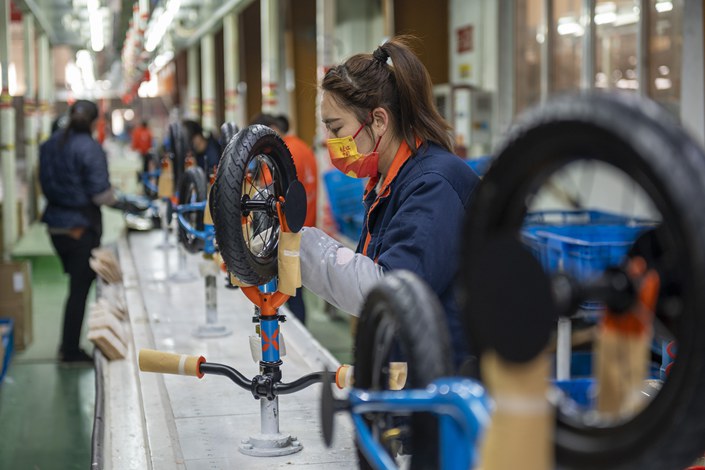
The Two Sessions — the annual meetings of the National People’s Congress (NPC) and the Chinese People’s Political Consultative Conference (CPPCC) — will soon be convened and many are waiting to see how the government work report will set economic growth targets. The current situation — with the pandemic drawing to an end while the international situation is in turmoil — requires China to expand its vision to the whole world in formulating its development plan. In particular, China should clearly define its position in the global industrial, supply and value chains, and build itself into an innovative country while embracing globalization.
In 2022, the Chinese economy will face myriad uncertainties, both at home and abroad. To achieve progress while “maintaining stability in six areas,” China should further stabilize foreign trade, foreign investment and expectations, and advance to the upper reaches of the industrial chain on the basis of deep participation in the international division of labor and cooperation. Amid fierce international competition, we can either forge ahead or drift downstream.
The global industrial and supply chains, formed by a long globalization process, are constantly changing yet relatively stable. In the past two years, the virus has had an enormous impact on the economies of all countries, while also affecting the layout of the global industrial chain. China, however, has bucked the global trend. By virtue of its comparative advantage in epidemic prevention and control, China has filled the gaps in the global industrial chain caused by the pandemic, thus consolidating and even enhancing its share of international trade. Despite repeated worldwide outbreaks due to emerging COVID-19 variants, some countries — such as the U.K. — have announced the lifting of all prevention and control measures as vaccines and efficient COVID-19 drugs have become more widely available. The growing sense around the globe is that the pandemic that has ravaged the world is coming to an end. According to the latest World Trade Organization’s (WTO) Goods Trade Barometer figures released a few days ago, the growth of international trade slowed at the beginning of 2022 but has recently shown signs of bottoming out and it is likely to pick up soon, as pressure on supply chains is eased.
Global supply chains will make timely adjustments to return to normal. This is a double-edged sword for China’s economy: On one hand, when international trade actually returns to normal, global trade will bottom out and rebound, which will definitely benefit China. On the other hand, this might mean the end of the so-called “pandemic dividends” in foreign trade that China has enjoyed over the past two years, and some domestic industries may continue the pre-pandemic trend of moving to neighboring countries. However, the end of the pandemic will not be, as some have predicted, the end of the “advantageous era” of China’s foreign trade. Though the advantages in foreign trade brought by the pandemic may be short-lived, China’s prospects depend on whether China’s industrial chain can make timely adjustments and transform the pressure into a driving force of steady progress.
In addition to the pandemic, there are some other factors that may impact the global economy in 2022. In particular, central banks, including that of the U.S. and several EU countries have announced a rise in interest rates, some of which have already been implemented. To cope with the inflation, monetary authorities such as the U.S. Federal Reserve have introduced quantitative easing policies, raising interest rates and reducing the balance sheet. This will affect global liquidity and bring some constraints on the formulation and implementation of China’s monetary policy. Besides, international geopolitical risk incidents, most notably the Russo-Ukrainian War, will disturb the normal economic and trade relations between countries and influence global supply chains, especially the stability of the international energy market. China will not be a bystander.
Overall, because of the accelerated changes to global industrial chains caused by the pandemic, the internal and external environment that China is facing has become more complicated and uncertain. On the other hand, China’s economic development is under the pressures of shrinking demand, supply shocks and lowered expectations. Under these circumstances, China’s economic development in 2022 should aim for steady growth and strive to advance to the upper reaches of the industrial chain. We should accelerate the building of a new development pattern of dual circulation. In this pattern, the domestic and foreign markets reinforce each other, with the domestic market as the mainstay, to create a good international economic and trade environment for high-quality development.
In recent years, Chinese enterprises have made considerable progress in the global industrial chain division system. In the past, Chinese industries mainly congregated in the lower part and made profits by doing hard labor. Looking at the current situation, the improvement is fairly obvious. Studies have found that, since 1990, China has gradually taken on a greater role in designing the front end of the industrial chain and R&D to take part in the labor division of global trade. Meanwhile, the proportion of the labor-intensive manufacturing and processing industry has shown a declining trend. Since 2010, China’s manufacturing industry has relied less on intermediate goods and its independent controllability has improved.
This can also be proved from another angle. Since 2018, with the trade friction between China and the U.S., the U.S. has imposed tariffs on a wide range of imports from China, but it has also issued a tariff exemption list for many imports from the country, allowing for unforeseen circumstances. The list mainly covers mechanical equipment and mechanical and electrical products, areas where the U.S. is highly dependent on China. Since the outbreak of COVID-19, pandemic prevention materials produced by China have also been included in the list, helping China’s exports to the U.S. retain its high level of growth. Of course, if China had not made progress in the global industrial chain division system over the years, it would have played a more passive role in the international economic and trade frictions and the pandemic hit. This fully demonstrates the importance of innovation capability and scientific and technological strength in international competition.
However, being closer to the international frontier makes it more difficult to make progress. Moreover, the countries ahead of China are blocking the way forward, while other upcoming countries are breathing down China’s neck. Therefore, the urgent task for the country is to advance to the upper reaches of the industrial chain by intensively developing itself as an innovative country. To this end, it needs to give priority to academic freedom and deepen the reform of the educational science and technology system. Only with sufficient scientific, technological and innovative strength can it fundamentally avoid getting stuck in the bottleneck of technologies and industries.
Of course, scientific and technological innovation should not be isolated from the international community. Instead, it should be consciously integrated into the international economic cycle. To this end, China should continue to deepen its institutional opening up. There are already some profound lessons we can learn from — some countries, endowed with vast resources but unable to break away from rigidity or stagnation, have experienced economic declines and have fallen behind in the international industrial chain.
Regardless of when the pandemic ends or how the global industrial chain is adjusted, what China can do is to concentrate on “doing its own thing,” promoting high-quality economic development and advancing to the upper reaches of the industrial chain on the basis of deep participation in the international division of labor and cooperation. This will be the best way for China to create stability while dealing with various internal and external uncertainties. Therefore, at the Two Sessions, we expect these issues to be comprehensively dealt with in the government work report.
Get our weekly free Must-Read newsletter.







